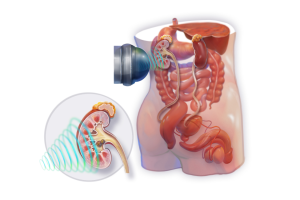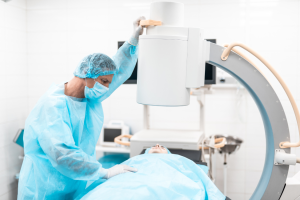Extracorporeal Shockwave Lithotripsy (ESWL)
Kidney stones are an exceptionally common buildup of minerals in the kidneys, often due to dehydration and poor lifestyle choices. Here in Charlotte, our summers are very warm, and frequently, patients do not drink enough water. This means that the tiny crystals in their urine can start to bind and form larger stone-like structures. Once a stone has formed, new crystals bind to it and get bigger. Eventually, when the stone causes a backup of urine in the kidney, it can cause excruciating pain that many liken to childbirth. Smaller stones may pass through the urine. For others, however, the stone can become lodged in the ureter or within the kidney itself. These stones may require treatment, one of which is ESWL.
What is ESWL

ESWL, or extracorporeal shockwave lithotripsy, appeals to most patients because it is painless and noninvasive. No medical devices are passed through the urethra or the skin, as with other stone procedures. During ESWL, a shockwave-generating machine is placed over the area of the kidney. Using advanced imaging technology, Doctor Natale can focus squarely on the kidney stone; at this point, small shockwave pulses are aimed at the kidney. It may require thousands of these pulses to break up the kidney stones throughout the treatment. The urologist monitors the device to ensure efficacy and safety while patients remain under anesthesia. ESWL is best suited for relatively softer kidney stones located in the kidney.
How effective is ESWL?
In the appropriately selected patient, ESWL can be very effective in pulverizing a softer kidney stone and allowing it to be passed through the urine. However, ESWL does have a few drawbacks. First, since there is no direct visualization or treatment of the stone as with ureteroscopy or PCNL, only softer formations are suitable for this treatment. Further, if the stone is lodged in the ureter, ESWL is typically not the ideal procedure. In addition, it is not only possible but likely that the ESWL will not eliminate the entirety of the kidney stone. As our kidney stone overview mentioned, new crystals stick to existing stone formations, creating larger stones and recurrence of symptoms. As such, if you are not stone-free after your procedure, there is some likelihood that the kidney stone will recur at some point in the future and require additional treatment.
Do we recommend ESWL?
 The short answer is yes; we do when it is in the right patient. ESWL is an excellent solution for specific kidney stones, and most patients love that they do not have an invasive procedure ahead of them. Dr. Natalie will be very candid with his patients, hoping they understand when this may not be ideal and that something more invasive may be necessary to ensure a stone-free future. Fortunately, if ESWL fails to eliminate the entire kidney stone, ureteroscopy or PCNL can be used to remove the rest of the stone.
The short answer is yes; we do when it is in the right patient. ESWL is an excellent solution for specific kidney stones, and most patients love that they do not have an invasive procedure ahead of them. Dr. Natalie will be very candid with his patients, hoping they understand when this may not be ideal and that something more invasive may be necessary to ensure a stone-free future. Fortunately, if ESWL fails to eliminate the entire kidney stone, ureteroscopy or PCNL can be used to remove the rest of the stone.
The bottom line
We have proven effective and safe solutions to virtually every size and kind of kidney stone. Most importantly, we hope you will visit a urologist such as Dr. Natale at the first signs of a kidney stone to minimize the risks and complications associated with an untreated kidney stone and urinary backup. Further, kidney stones within the kidney itself can become very large and impede renal function even if there aren’t many outward symptoms. With a thorough discussion with Dr. Natalie, you’ll better understand your kind of kidney stone and what treatment is necessary to eliminate it. From there, Dr. Natalie will discuss the treatment options and help you strategize how to move forward.
